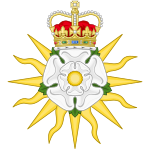
The College of Arms, or Heralds' College, is a royal corporation consisting of professional officers of arms, with jurisdiction over England, Wales, Northern Ireland and some Commonwealth realms. The heralds are appointed by the British Sovereign and are delegated authority to act on behalf of the Crown in all matters of heraldry, the granting of new coats of arms, genealogical research and the recording of pedigrees. The College is also the official body responsible for matters relating to the flying of flags on land, and it maintains the official registers of flags and other national symbols. Though a part of the Royal Household of the United Kingdom, the College is self-financed, unsupported by any public funds.

The Garter Principal King of Arms is the senior King of Arms, and the senior Officer of Arms of the College of Arms, the heraldic authority with jurisdiction over England, Wales and Northern Ireland. The position has existed since 1415.

Richmond Herald of Arms in Ordinary is an officer of arms of the College of Arms in England. From 1421 to 1485, Richmond was a herald to John, Duke of Bedford, George, Duke of Clarence, and Henry, Earl of Richmond, all of whom held the Honour (estate) of Richmond. However, on the accession of Henry as Henry VII of England in 1485, Richmond became a king of arms and remained so until 1510, when the office became that of a herald in ordinary of the Crown. The badge of office is a red rose of Lancaster dimidiating the white rose en soleil of York, ensigned by the royal crown. Although this device has all the characteristics of a Tudor invention, it is likely to be of fairly recent derivation.
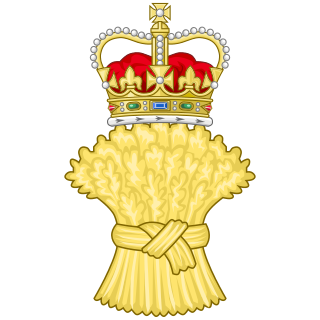
Chester Herald of Arms in Ordinary is an officer of arms at the College of Arms in London. The office of Chester Herald dates from the 14th century, and it is reputed that the holder was herald to Edward, Prince of Wales, also known as the Black Prince. In the reign of King Richard II the officer was attached to the Principality of Chester, which was a perquisite of the then Prince of Wales. In the reign of King Henry VIII the title lapsed for a time but, since 1525, the office of Chester has been one of unbroken succession, as a herald in ordinary. The badge of office is taken from the arms of the Earl of Chester and in blazoned as A Garb ensigned of the Royal Crown Or.
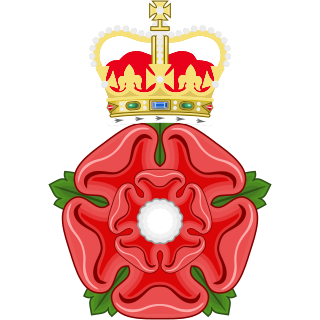
Lancaster Herald of Arms in Ordinary is an English officer of arms at the College of Arms in London. The title of Lancaster Herald first occurs in 1347 at Calais, and to begin with this officer was a servant to the noble house of Lancaster. As a retainer of John of Gaunt (1377–1399) Lancaster was advanced to the rank of King of Arms, and was later promoted to the royal household of Henry IV, and made king of the northern province. This arrangement continued until 1464, when Lancaster reverted to the rank of herald. Since the reign of King Henry VII (1485–1509) Lancaster has been a herald in ordinary. The badge of office is a red rose of Lancaster, royally crowned.

Somerset Herald of Arms in Ordinary is an officer of arms at the College of Arms in London. In the year 1448 Somerset Herald is known to have served the Duke of Somerset, but by the time of the coronation of King Henry VII in 1485 his successor appears to have been raised to the rank of a royal officer, when he was the only herald to receive coronation liveries.

Windsor Herald of Arms in Ordinary is an officer of arms at the College of Arms in London.
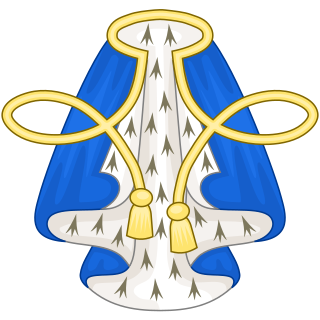
Bluemantle Pursuivant of Arms in Ordinary is a junior officer of arms of the College of Arms in London. The office is reputed to have been created by King Henry V to serve the Order of the Garter, but there is no documentary evidence of this. There is, however, mention of an officer styled Blewmantle going to France in 1448. The first Bluemantle to be mentioned by name is found in a record from around 1484. The badge of office, probably derived from the original blue material of the Order of the Garter, is blazoned as A Blue Mantle lined Ermine cords and tassels Or.

Rouge Dragon Pursuivant of Arms in Ordinary is a junior officer of arms of the College of Arms, named after the red dragon of Wales.

Portcullis Pursuivant of Arms in Ordinary is a junior officer of arms at the College of Arms in London. The office is named after the Portcullis chained Or badge of the Beauforts, which was a favourite device of King Henry VII. King Henry's mother was Lady Margaret Beaufort. The office was instituted around 1485, probably at the time of Henry's coronation. The badge of office is very similar to that of Somerset Herald of Arms in Ordinary, the latter being ensigned with the Royal Crown. The earliest recorded Portcullis Pursuivant was James or Jacques Videt, who was the plaintiff in a Common Pleas case in 1498 and again in 1500.
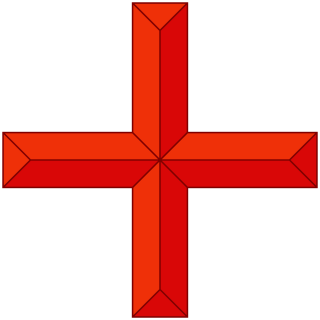
Rouge Croix Pursuivant of Arms in Ordinary is a junior officer of arms of the College of Arms. He is said to be the oldest of the four pursuivants in ordinary. The office is named after St George's Cross which has been a symbol of England since the time of the Crusades.

General Sir Rob McGregor MacDonald Lockhart was a senior British Army officer during the Second World War and later a leading member of the Scout Association.
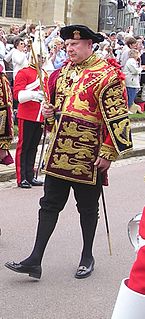
Sir Thomas Woodcock FRHSC (Hon), former Garter Principal King of Arms, is a former member of the Royal Household and the senior herald and genealogist at the College of Arms in London.
Sir Henry Farnham Burke, (1859–1930) was a long-serving Anglo-Irish officer of arms at the College of Arms in London.

Sir Gerald Woods Wollaston was a long-serving officer of arms at the College of Arms in London. Wollaston's family had a firm tradition at the College of Arms. Wollaston's great-grandfather was Sir William Woods, Garter Principal King of Arms from 1838 until his death in 1842. His grandfather was Sir Albert William Woods who held the same post from 1869 to 1904.
John Riddell Bromhead Walker was a soldier and long-serving English officer of arms at the College of Arms in London.
Rodney Onslow Dennys, was a British foreign service operative and long-serving officer of arms at the College of Arms in London. During World War II he served in the Intelligence Corps of the British Army.
Major Charles Murray Kennedy St Clair, 17th Lord Sinclair, CVO, DL was a Scottish peer who spent his entire life in the service of the Crown; as a soldier, an officer of arms, an equerry in the Queen Mother's Household, a representative peer and as a Lord Lieutenant.
The Gentleman Usher of the Scarlet Rod is the Gentleman Usher to the Most Honourable Order of the Bath, established 14 January 1726.
Mowbray Herald of Arms Extraordinary was an English officer of arms. From the time of King Richard II to that of Henry VI, Mowbray was the Duke of Norfolk's private herald. Since its revival in 1623 the title has always been given to a herald extraordinary. Though an officer of the crown, Mowbray Herald Extraordinary was not a member of the corporation of the College of Arms in London. Sir William le Neve appears to have been appointed to the office from 29 June 1624 until his appointment as York Herald the following year. The office was recreated in January 1695 for Robert Plot, who was made Registrar of the College of Heralds just two days later and was subsequently held by Joseph Edmondson.
